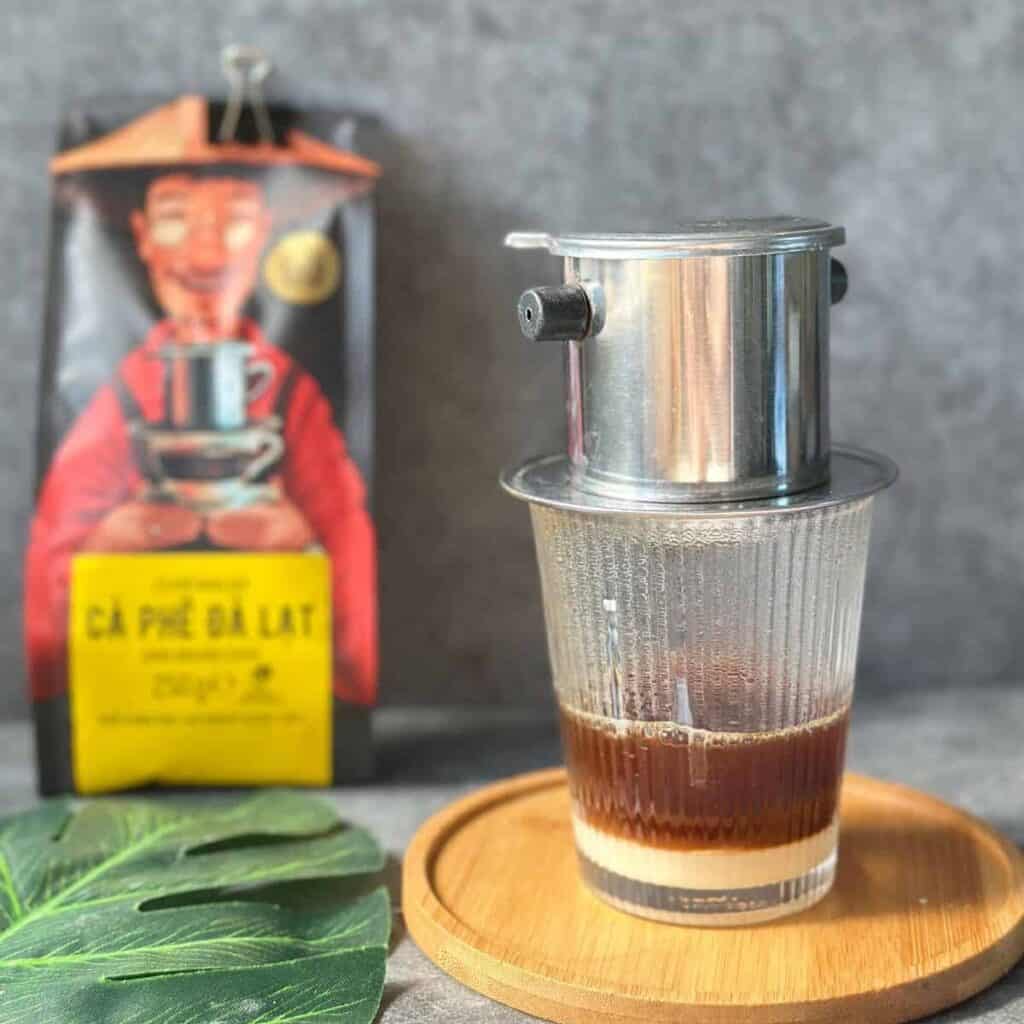For me, Gỏi Cuốn (Vietnamese Spring Rolls) isn’t just a recipe—it’s a memory of sitting around the table, rolling as we talked, and dipping each bite into that irresistible peanut sauce. Fresh, simple, and made to share.
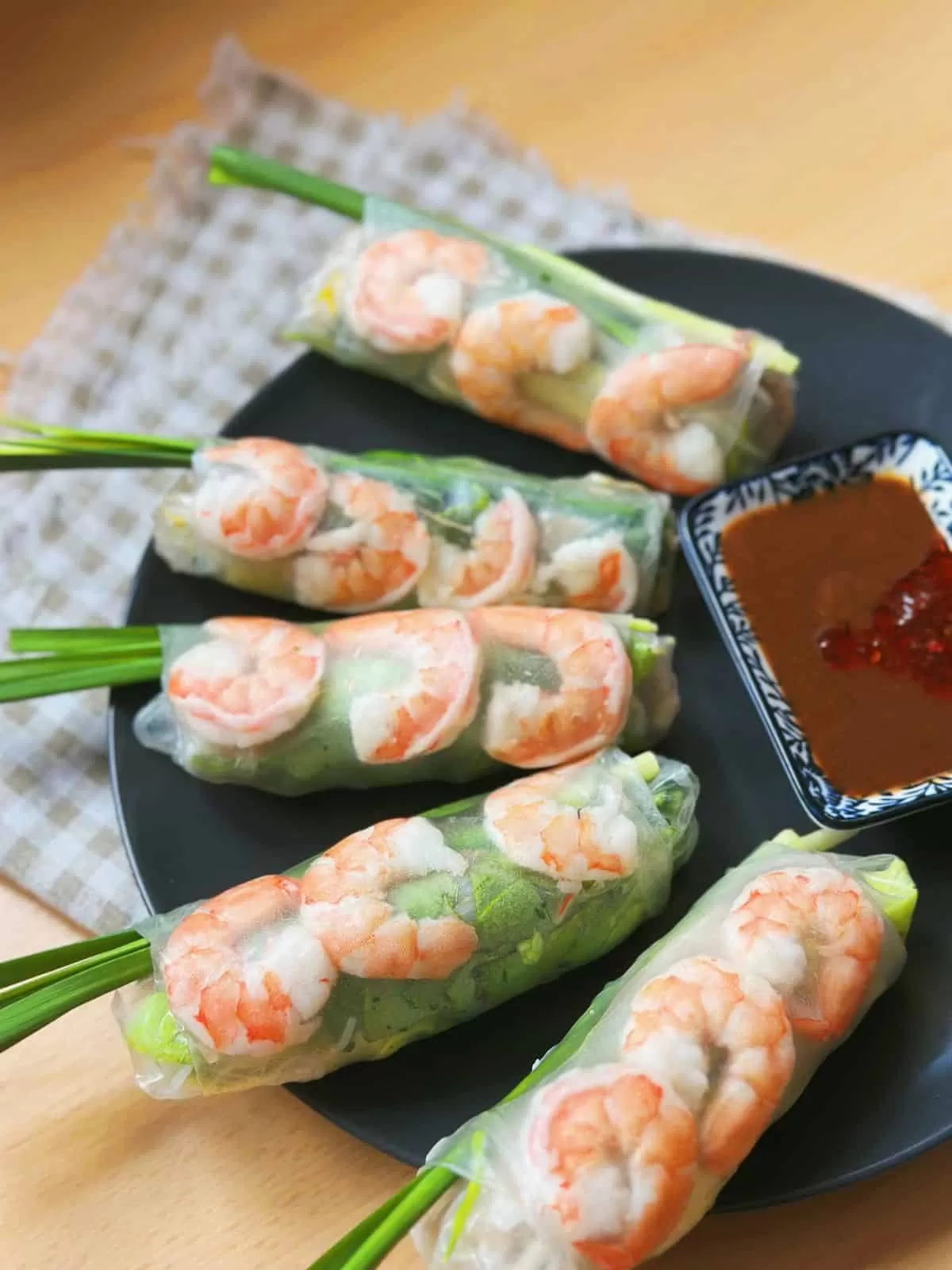
What is Gỏi Cuốn?
In North America, Gỏi Cuốn is best known as “Vietnamese spring rolls.”
Elsewhere, you might hear “summer rolls” or “rice paper rolls.” But in Vietnam, the name literally translates to “salad rolls.”
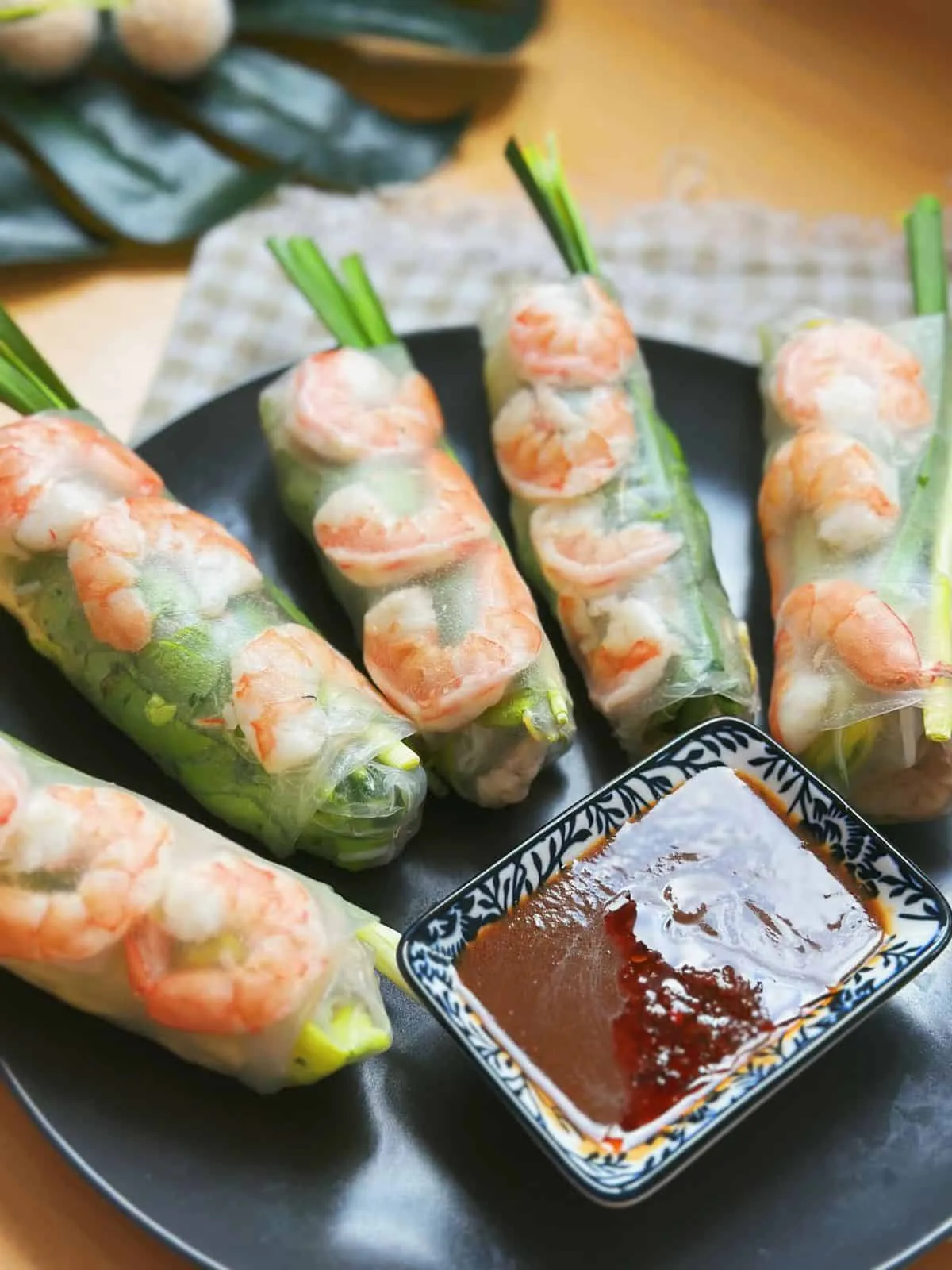
In the South, “Gỏi” is our word for salad—think Gỏi Gà (Vietnamese chicken salad)—and “Cuốn” just means roll.
The most common version is with shrimp and pork, but there are so many other tasty ones too: Bò Bía with Chinese sausage and jicama, Nem Nướng Cuốn with grilled pork sausage, or even a simple chicken rice paper roll.
These fresh rolls are definitely not the same as the crispy Vietnamese fried spring rolls made from rice paper (Nem Rán or Chả Giò)—or the classic egg rolls, for that matter.
Peanut Dipping Sauce and Beyond
When it comes to Gỏi Cuốn, the go-to dip is Vietnamese peanut sauce (though to be honest, it’s more hoisin-based). Creamy, sweet, and savory—it’s the kind of sauce that instantly makes every bite better.

I actually picked up this recipe from a lunch lady in Saigon. Just like many locals, I love to top mine with a drizzle of lemongrass chili oil (Sa Tế) and a spoonful of pickled carrots & daikon (Đồ Chua) for extra flavor and crunch.
If you’re craving something lighter, the sweet-tangy Nước Chấm (Vietnamese dipping fish sauce) is a perfect match for shrimp and pork spring rolls. And to my surprise, there are even more sauces that pair wonderfully with Gỏi Cuốn:
Ingredients
Fillings
I know spring rolls are super versatile—you can throw in almost any protein or veggie you like. But for Gỏi Cuốn, I want to show you the ingredients we usually use back home in Vietnam:
- Rice paper (Bánh Tráng): Choose the thin, see-through kind made especially for fresh rolls. And don’t worry if wrapping feels tricky—I’ve got a full guide to help you roll Vietnamese spring rolls like a pro.
- Shrimp: Lightly cooked, then sliced in half—this gives the roll its signature look and that juicy bite.
- Boiled pork belly: The classic pick. But pork shoulder, loin, or even poached chicken work if you prefer.
- Cooked rice vermicelli (Bún): Soft, delicate noodles that hold the fillings together inside the roll. Many Vietnamese abroad like to use Bánh Hỏi (woven rice noodle sheets) instead—it’s easier to prep, less slippery, less messy, and quicker to portion when wrapping.
- Veggies & Vietnamese herbs: Fresh lettuce, crisp cucumber or carrot matchsticks, bean sprouts, and plenty of herbs like cilantro, mint, Thai basil, or chives.


Peanut Dipping Sauce
- Hoisin sauce – adds that sweet, savory, slightly tangy base.
- Peanut butter – brings creaminess and a rich nutty flavor.
- Soy sauce – balances with saltiness and depth.
- Rice vinegar – a splash of brightness to cut through the richness.
- Water – thins the sauce to just the right dipping consistency.
Instructions
Step 1: Make the dipping sauce
- Stir all the dipping sauce ingredients until smooth, then adjust the flavors to suit your taste.
- Finish it off with a drizzle of Vietnamese chili oil and a spoonful of pickled veggies before serving.
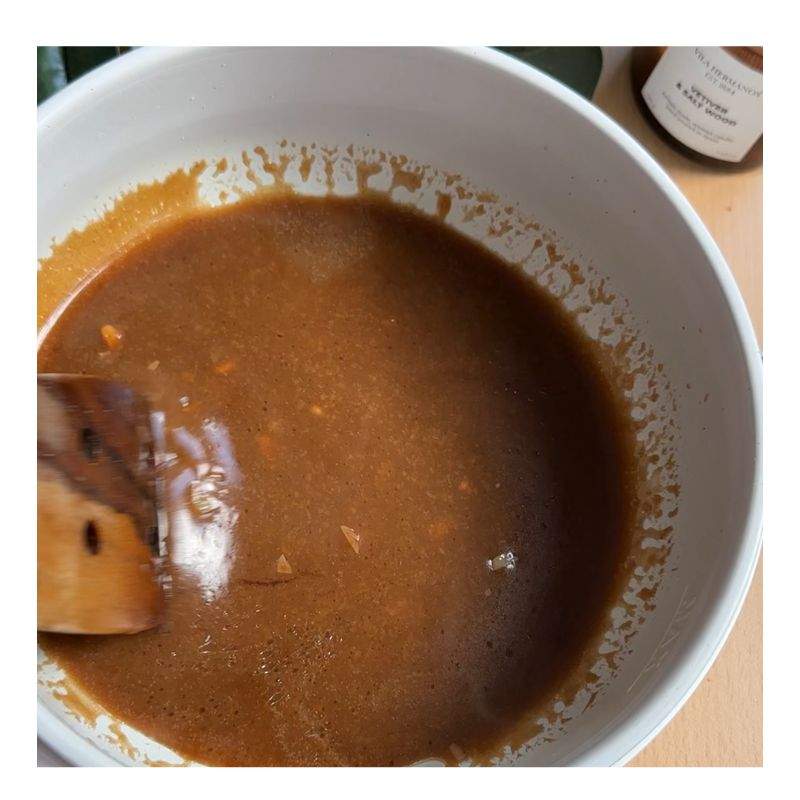
Step 2: Prep the fillings
- Boil pork belly with ginger, green onions, or shallots to remove odors. Cook for ~15 minutes, let cool, and slice thinly.

- Boil shrimp for ~3 minutes until pink, slice in half lengthwise.
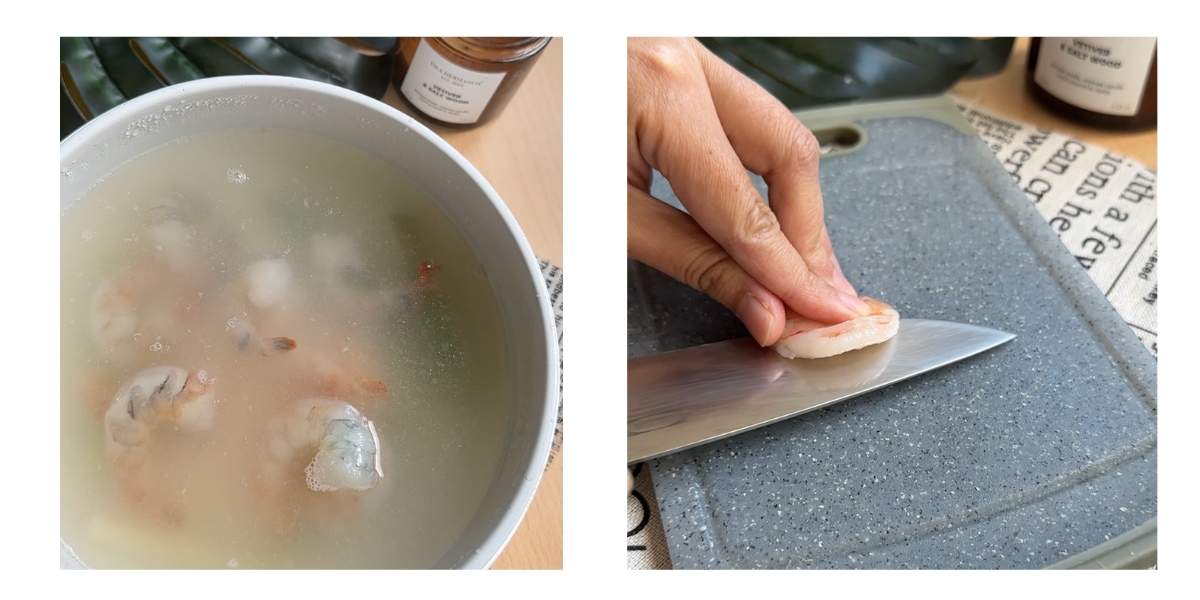
- Cook the rice vermicelli, then rinse under cold water and drain well. If using Bánh Hỏi, soak it in boiling water with a splash of oil for about 3 minutes until tender, then rinse with cold water and drain thoroughly.
- Slice fresh veggies like cucumber or carrot matchsticks.
Step 3: Assemble the rolls
- Quickly dip a rice paper in water (about 5 seconds) until pliable.
- On the lower half, layer lettuce, vermicelli, pork, and herbs.
- Place shrimp near the top, belly side down. Fold in the sides, fold up the bottom, then roll tightly, tucking in a sprig of chive before sealing.
- Repeat with remaining ingredients and serve with peanut sauce.
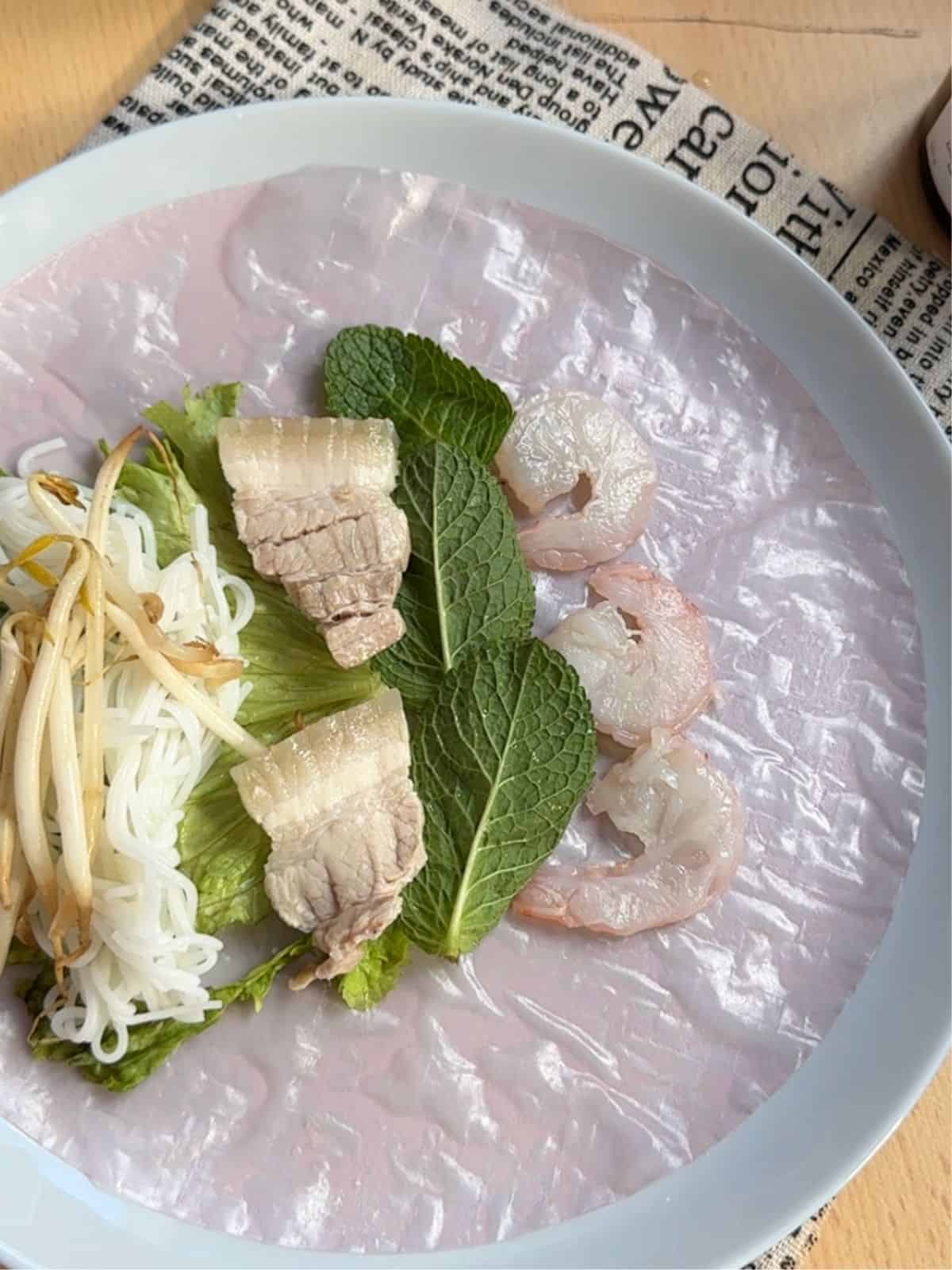
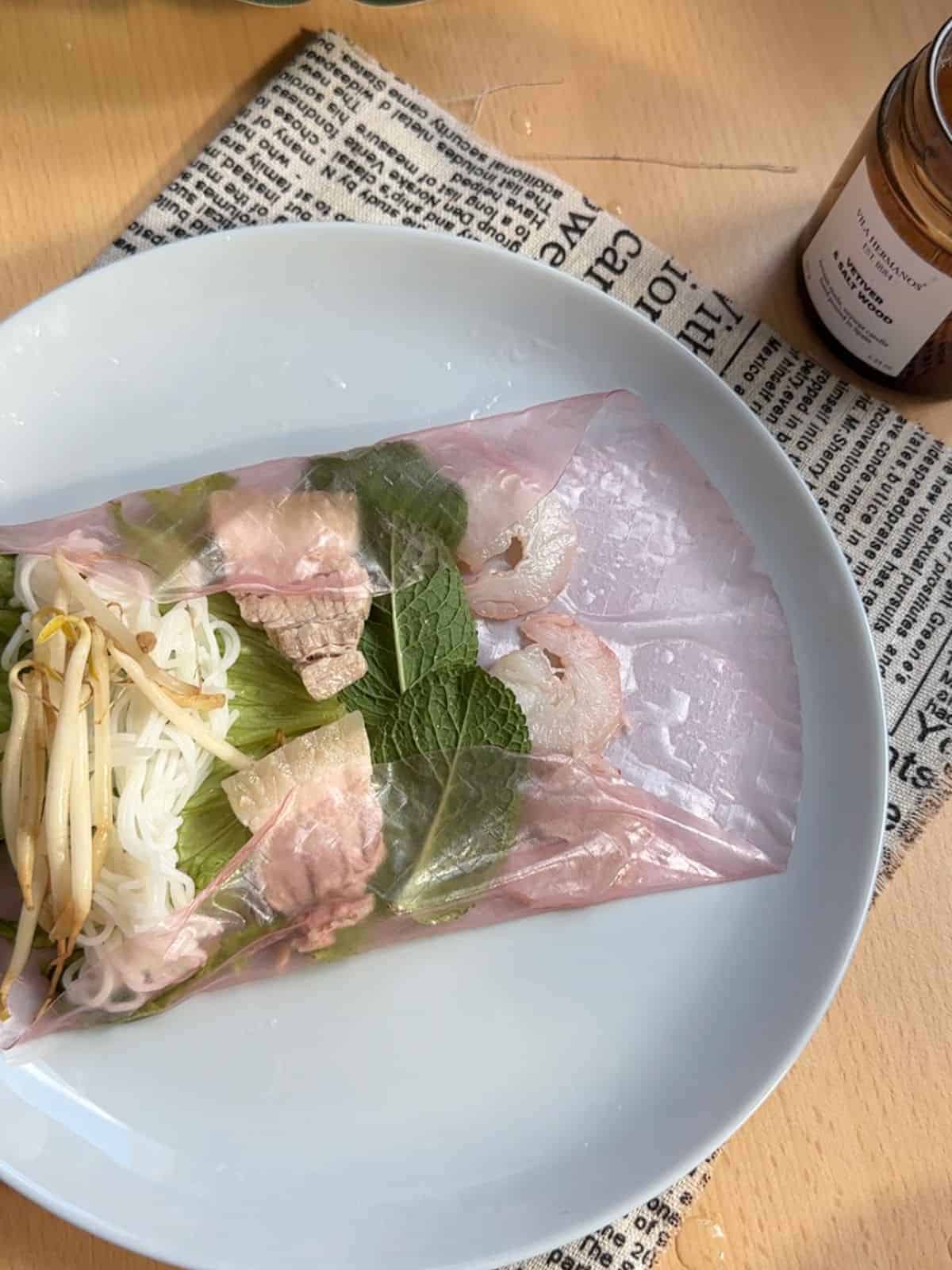
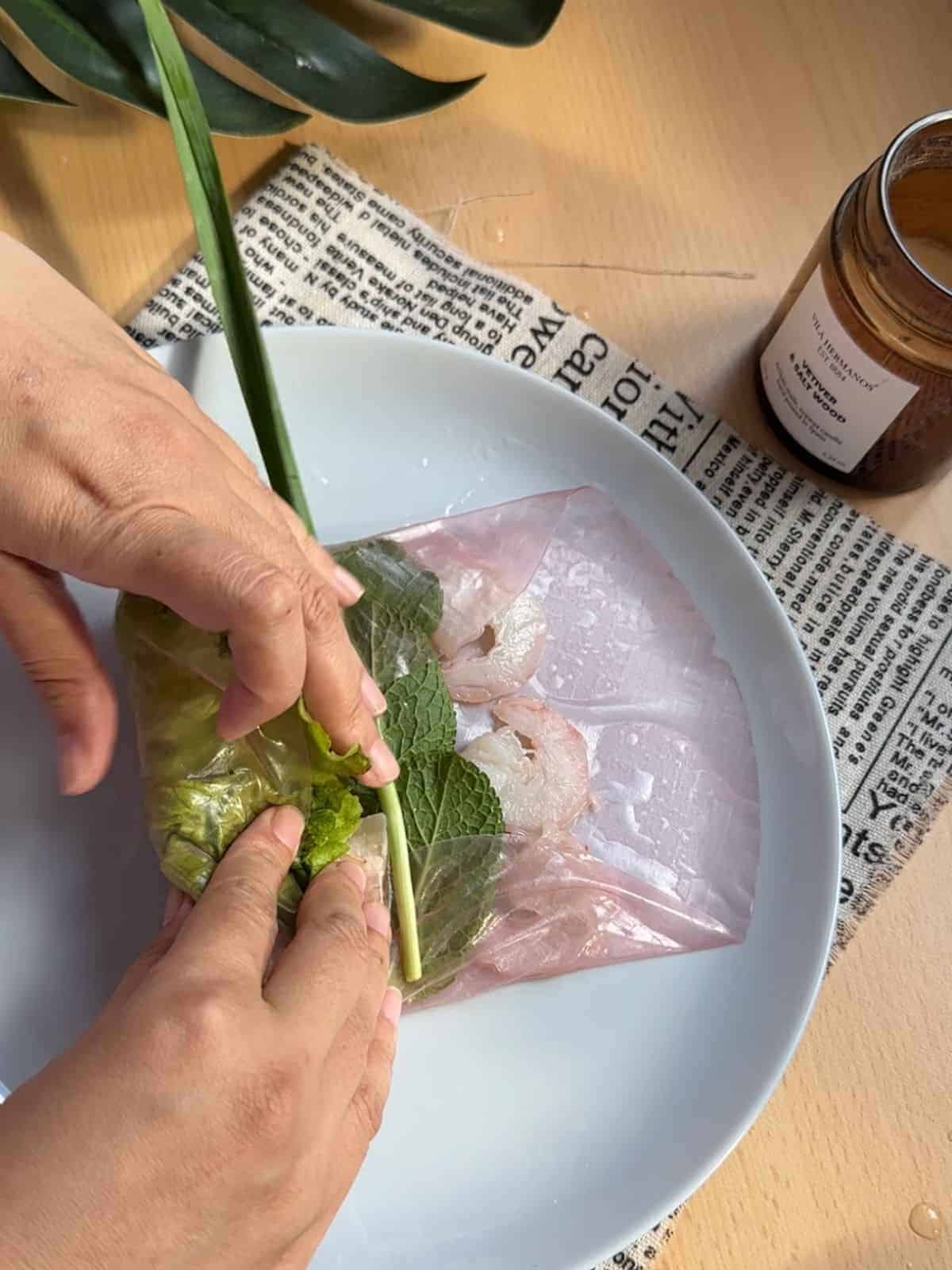
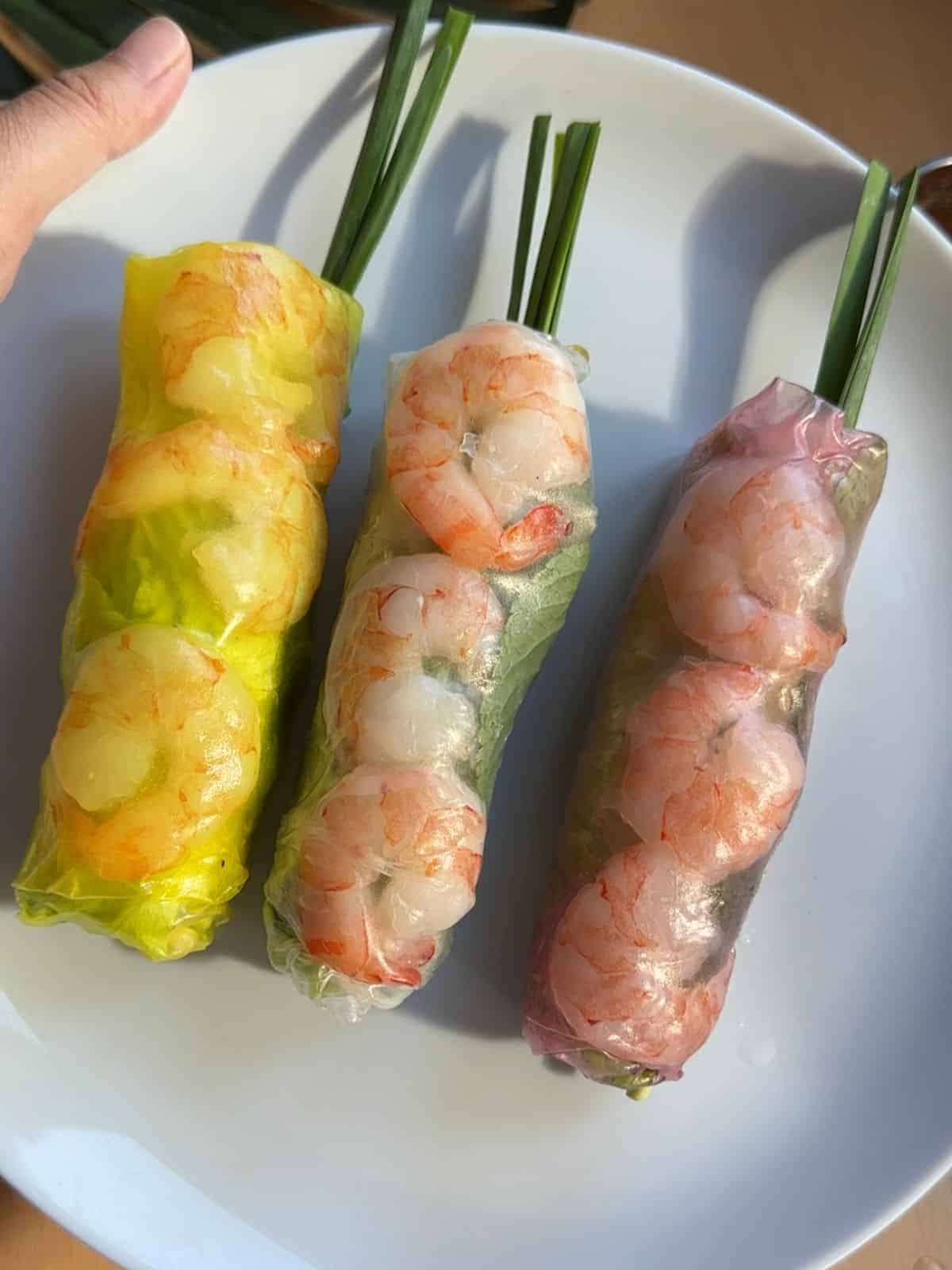
Instructional Video
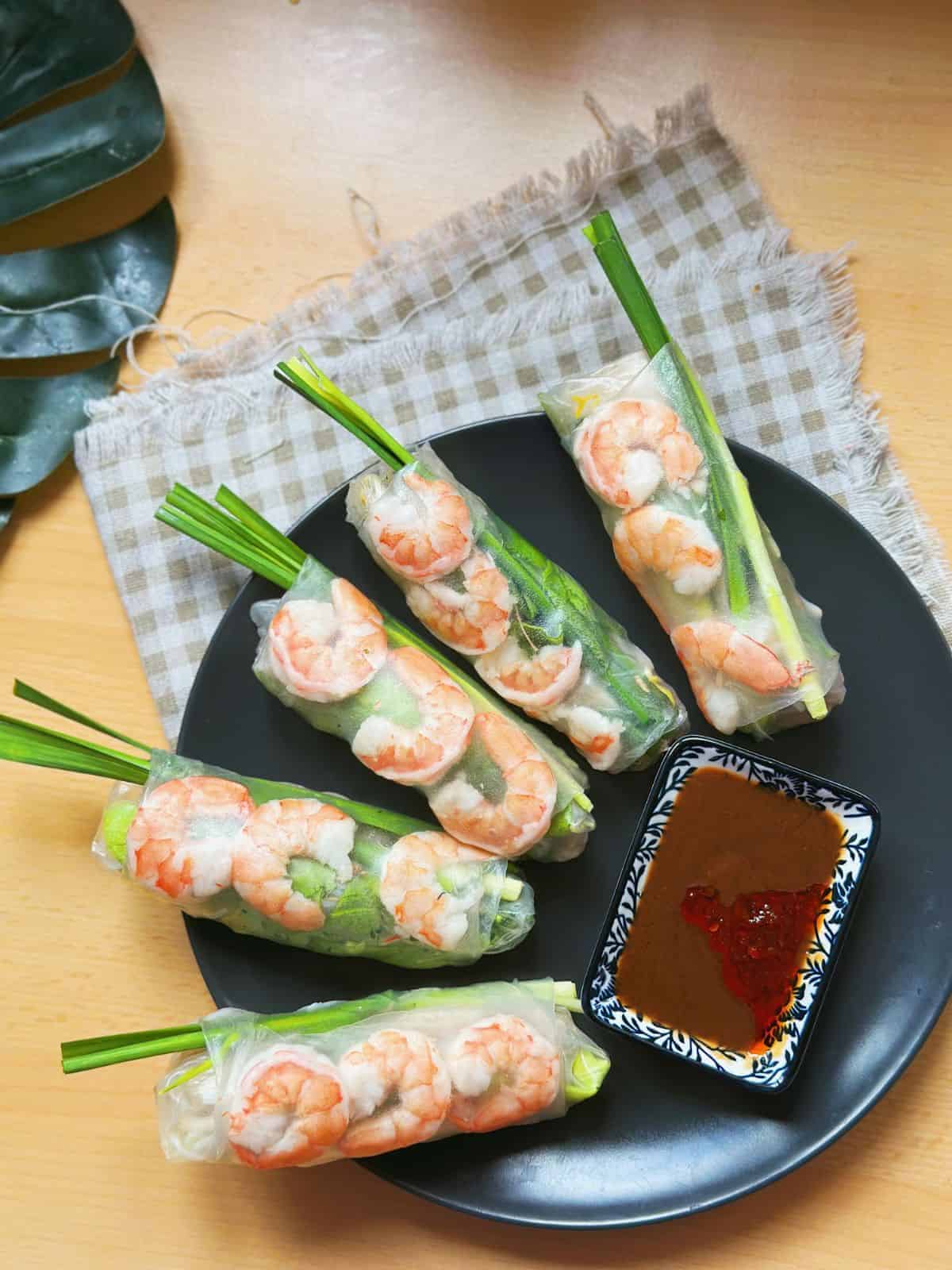
How to Serve Vietnamese Spring Rolls
In Vietnam, we usually enjoy Gỏi Cuốn in two simple (and delicious) ways:
Pre-rolled and ready to eat – The version you’ll see at street stalls. Just grab one, dip into the sauce, and enjoy. Fresh, quick, and perfect for eating on the go.
DIY rice paper platter at home – My favorite way. We spread everything out on the table: rice paper, boiled pork belly, shrimp, plenty of herbs, and crisp lettuce. Everyone rolls their own, turning dinner into a fun, hands-on feast.
And for the platter, don’t feel tied to shrimp and pork—lemongrass chicken, Vietnamese grilled pork, steamed fish or grilled fish, thit heo quay (crispy pork belly) or even cha lua (Vietnamese pork sausage) all make fantastic fillings.
FAQs
More Delicious Recipes from Southern Vietnam

(Vietnamese Sizzling Pancakes)

(Saigon-style)

(Vietnamese Sweet & Sour Soup)

Vietnamese Rice Paper Rolls (Gỏi Cuốn)
Ingredients
- 10 Rice papers
- 15 Shrimp
- ⅔ pound Pork Belly (300g)
- ⅓ pound Dried Thin Rice vermicelli (or Bánh Hỏi) (150g)
- Assortment of vegetables and herb (lettuce, bean sprouts, Thai basils, chives, mint, etc.)
Peanut Sauce
- 3 tbsp Hoisin Sauce
- ½ tbsp Peanut Butter
- 4 tbsp Hot Water
- ½ tbsp Soy Sauce (to your taste)
- ⅛ tsp Sugar (to your taste)
- ⅛ tsp Rice Vinegar (to your taste)
- ½ tsp Garlic Powder
Instructions
Make dipping sauce:
- Mix all ingredients until well-combined.
Prep all your ingredients:
- To remove strong pork odors, add ginger, green onions, or shallots to boiling water. Boil the pork belly for about 15 minutes, or until it’s no longer pink when pierced. Remove, let cool, and slice thinly. Set aside.
- Next, bring the pot to a boil and add the shrimp, cooking them until they turn a vibrant pink color, which usually takes around 3 minutes.
- Bring the pot to a boil, add the shrimp, and cook for about 3 minutes until they turn pink. Remove, slice them lengthwise, and set aside.
- Cook the rice vermicelli according to the instructions on the package. Once done, rinse the vermicelli with cold water and thoroughly drain. For Bánh Hỏi, simply soak in boiling water with a little oil for about 3 minutes until soft, then rinse under cold water and drain completely.
- Lastly, slice the crunchy vegetables such as cucumber to complement the dish.
Assemble the rolls:
- Fill a large bowl with water. Take a rice paper and dip it quickly (around 5 seconds) into the water, ensuring that any excess water is shaken off. The rice paper then will become soft and pliable.
- Place the softened rice paper on a plate, smooth side down. At the bottom, layer some lettuce, rice vermicelli, sliced pork belly, and fresh herbs. At the top, place the shrimp with the belly facing down, so they’re visible when the roll is made, making it look even more appetizing!
- Fold the sides of the rice paper inwards towards the center. Then, fold the bottom edge of the rice paper over the filling.
- Roll the rice paper tightly to enclose the filling. As you near the top, add a sprig of chive and continue rolling to seal it securely.
- Repeat steps 1 to 3 with the remaining ingredients to create more spring rolls.
- Serve the spring rolls with peanut dipping sauce.

